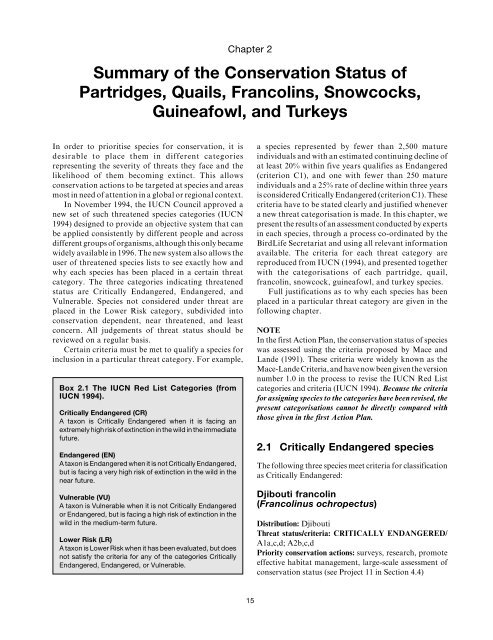Partridges, Quails, Francolins, Snowcocks, Guineafowl, and Turkeys
Partridges, Quails, Francolins, Snowcocks, Guineafowl, and Turkeys
Partridges, Quails, Francolins, Snowcocks, Guineafowl, and Turkeys
You also want an ePaper? Increase the reach of your titles
YUMPU automatically turns print PDFs into web optimized ePapers that Google loves.
Chapter 2<br />
Summary of the Conservation Status of<br />
<strong>Partridges</strong>, <strong>Quails</strong>, <strong>Francolins</strong>, <strong>Snowcocks</strong>,<br />
<strong>Guineafowl</strong>, <strong>and</strong> <strong>Turkeys</strong><br />
In order to prioritise species for conservation, it is<br />
desirable to place them in different categories<br />
representing the severity of threats they face <strong>and</strong> the<br />
likelihood of them becoming extinct. This allows<br />
conservation actions to be targeted at species <strong>and</strong> areas<br />
most in need of attention in a global or regional context.<br />
In November 1994, the IUCN Council approved a<br />
new set of such threatened species categories (IUCN<br />
1994) designed to provide an objective system that can<br />
be applied consistently by different people <strong>and</strong> across<br />
different groups of organisms, although this only became<br />
widely available in 1996. The new system also allows the<br />
user of threatened species lists to see exactly how <strong>and</strong><br />
why each species has been placed in a certain threat<br />
category. The three categories indicating threatened<br />
status are Critically Endangered, Endangered, <strong>and</strong><br />
Vulnerable. Species not considered under threat are<br />
placed in the Lower Risk category, subdivided into<br />
conservation dependent, near threatened, <strong>and</strong> least<br />
concern. All judgements of threat status should be<br />
reviewed on a regular basis.<br />
Certain criteria must be met to qualify a species for<br />
inclusion in a particular threat category. For example,<br />
Box 2.1 The IUCN Red List Categories (from<br />
IUCN 1994).<br />
Critically Endangered (CR)<br />
A taxon is Critically Endangered when it is facing an<br />
extremely high risk of extinction in the wild in the immediate<br />
future.<br />
Endangered (EN)<br />
A taxon is Endangered when it is not Critically Endangered,<br />
but is facing a very high risk of extinction in the wild in the<br />
near future.<br />
Vulnerable (VU)<br />
A taxon is Vulnerable when it is not Critically Endangered<br />
or Endangered, but is facing a high risk of extinction in the<br />
wild in the medium-term future.<br />
Lower Risk (LR)<br />
A taxon is Lower Risk when it has been evaluated, but does<br />
not satisfy the criteria for any of the categories Critically<br />
Endangered, Endangered, or Vulnerable.<br />
a species represented by fewer than 2,500 mature<br />
individuals <strong>and</strong> with an estimated continuing decline of<br />
at least 20% within five years qualifies as Endangered<br />
(criterion C1), <strong>and</strong> one with fewer than 250 mature<br />
individuals <strong>and</strong> a 25% rate of decline within three years<br />
is considered Critically Endangered (criterion C1). These<br />
criteria have to be stated clearly <strong>and</strong> justified whenever<br />
a new threat categorisation is made. In this chapter, we<br />
present the results of an assessment conducted by experts<br />
in each species, through a process co-ordinated by the<br />
BirdLife Secretariat <strong>and</strong> using all relevant information<br />
available. The criteria for each threat category are<br />
reproduced from IUCN (1994), <strong>and</strong> presented together<br />
with the categorisations of each partridge, quail,<br />
francolin, snowcock, guineafowl, <strong>and</strong> turkey species.<br />
Full justifications as to why each species has been<br />
placed in a particular threat category are given in the<br />
following chapter.<br />
NOTE<br />
In the first Action Plan, the conservation status of species<br />
was assessed using the criteria proposed by Mace <strong>and</strong><br />
L<strong>and</strong>e (1991). These criteria were widely known as the<br />
Mace-L<strong>and</strong>e Criteria, <strong>and</strong> have now been given the version<br />
number 1.0 in the process to revise the IUCN Red List<br />
categories <strong>and</strong> criteria (IUCN 1994). Because the criteria<br />
for assigning species to the categories have been revised, the<br />
present categorisations cannot be directly compared with<br />
those given in the first Action Plan.<br />
2.1 Critically Endangered species<br />
The following three species meet criteria for classification<br />
as Critically Endangered:<br />
Djibouti francolin<br />
(Francolinus ochropectus)<br />
Distribution: Djibouti<br />
Threat status/criteria: CRITICALLY ENDANGERED/<br />
A1a,c,d; A2b,c,d<br />
Priority conservation actions: surveys, research, promote<br />
effective habitat management, large-scale assessment of<br />
conservation status (see Project 11 in Section 4.4)<br />
15

















